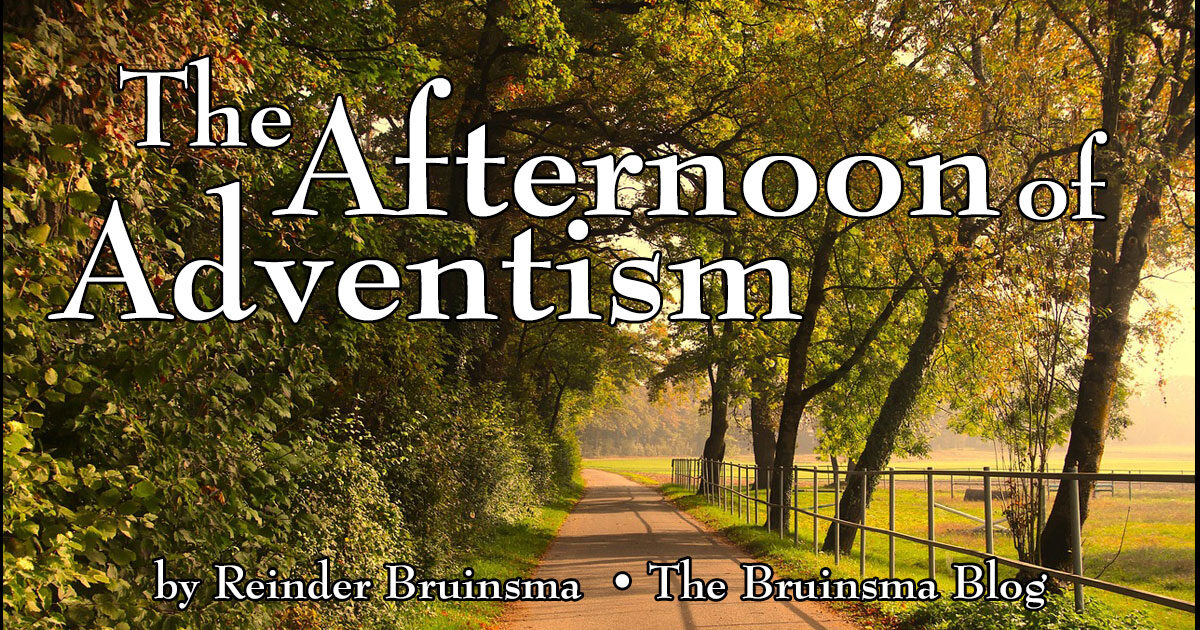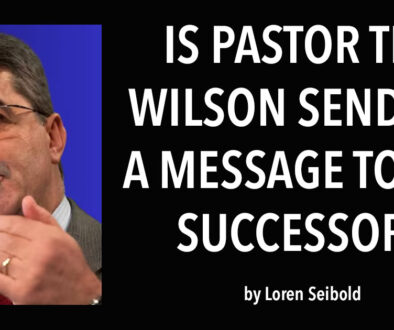The Afternoon of Adventism
by Reinder Bruinsma | 30 April 2025 |
After a day of preaching and teaching in Stuttgart, Germany not long ago, I was graciously presented with a copy of Tomáš Halík’s most recent book, The Afternoon of Christianity: The Courage to Change.
Tomáš Halík (b. 1948) is a Czech Roman Catholic priest and theologian who has also gained considerable fame as a philosopher and sociologist. He was secretly ordained to the priesthood in 1978, and worked as an underground priest in his country during the communist era. In 1989, after democracy was restored, he became an advisor to President Václav Havel to help restore religious life in his country. Halík remains an influential voice, and his books have been translated into over twenty languages.
In this new book Halík explores contemporary challenges to Christianity and pleads for a transformation of faith.
A church in crisis
Tomáš Halík loves his church, a fact to which he gave convincing proof during the years he served as an underground priest. His autobiography From the Underground Church to Freedom (University of Notre Dame Press, 2019) is both fascinating and sobering, especially for those who think that only Protestant believers have suffered for their faith.
Because Halík is so loyal to his church, he earns the right to be critical of its current state—indeed, of the state of Christianity in general. Halík considers his church, the Roman Catholic Church, as a part of Christianity; he never treats other Christians as second class or outside the “true” church. (Which is more than can be said of some of us.) The title of his newest book is about all of Christianity, not just the Roman Catholic Church.
The psychiatrist Carl Gustav Jung (1875-1961) compared human life with the flow of a day, in which morning is followed by noon, and then by the afternoon: the morning of an individual’s human life is often followed by a midlife crisis, before mature age and old age constitute the afternoon and evening of life. Halík uses the concept of the “afternoon of Christianity” to describe the present state of the Christian church. Christianity, says Halík, is in a serious mid-life crisis: there must be drastic change and renewal if the church is to have a meaningful future.
The crisis in Christianity is most visible in the western world, where the church is losing members, where attendance is dropping, and people feeling callings into ministry have reached an all-time low. The Catholic Church in particular has suffered under sexual and financial scandals and internal power struggles. The unity in that church leaves much to be desired, and internal differences are often greater than the variations between Catholics and other denominations. And although in many places there is considerable Catholic lay involvement, “it is always linked to the principle that all lay activity must be directed and controlled by the hierarchy” (p. 82).
Tomáš Halík is convinced that the Christian faith has outgrown previous forms of religion, and “every attempt to squeeze it back into one of the earlier forms is counterproductive” (p. 42). Nonetheless, we Christians need a community where we can experience our faith. “In historical reality, we always encounter faith within a culture, a cultural system” (p. 57) he says. The vital question for the Roman Catholic Church, as well as for the Christian church in general, is whether it can provide a common home for different kinds of religiosity (p. 98).
But when all is said and done, emphasizes Halík, the church’s survival rests on a combination of greater spirituality and a distinct relevancy to our present secularized world.
Crisis in Adventism
Halík’s description of the condition of current Roman Catholicism is uncannily similar to that of contemporary Seventh-day Adventism. Most of the problems he remarks about in his church are also true of my church. After years of strong and steady growth, in many places membership has stagnated. In some regions massive baptisms are still taking place, but the question Halík poses with regard to the Roman Catholic Church—whether the church is just producing statistics of baptized persons rather than practicing Christians—is equally applicable to the Adventist Church.
Our Adventist denomination also struggles with deplorable retention rates, with over 40 percent of newly baptized people leaving the church after a relatively short stay. In many places church attendance is hitting worrying lows.
It is also true among us that internal differences about doctrines and lifestyle are often greater than members’ experience with Christians in other denominations. I must admit that I sometimes feel closer to God when I meet with fellow Christians who belong to other denominations than when I sit in some of the Sabbath Schools I attend.
The (thus far, successful) opposition of Adventism’s top leadership to allowing women into ministry on an equal footing with men is one of the main reasons why there will be a dramatic shortage of Adventist pastors in the West in the foreseeable future.
The polarization in the Adventist Church has worsened to the point that many think a schism between different segments of the church is unavoidable—and one may wonder whether such a split has de facto not already taken place, in spite of all denials. The enormous influence of independent ministries in the conservative wing of the church, as well as the steadily strengthening voice of organizations in the more liberal segment of the church—both largely outside the control of the General Conference—show that Adventism has lost much of its earlier organizational and theological unity.
A midlife crisis
Returning to Halík’s metaphor of the morning, noon, and afternoon Christianity: I believe there are reasons to ask whether this also describes the past, present, and future of Adventism.
Our church has been a successful religious movement. Over the past 150-plus years the Adventist message has touched the hearts and minds of tens of millions of people in nearly every country in the world. And it has had innovative and well-orchestrated mechanisms to deliver that message. However, these mechanisms of delivery now belong mostly to the world of the past.
The more crucial factor is that the message itself has lost much of its power to convince. After almost two centuries of telling people that Jesus will come “soon”—probably in their lifetime—it has become impossible to sustain our earlier momentum. Talking about worldwide Sunday laws and an end-time scenario that builds on nineteenth-century enemy-thinking fails to inspire today’s Adventist believers. For many it is old news, increasingly unrealistic.
Many wonder whether their church can still satisfy their spiritual needs—whether it can offer the perspective of hope that the world needs in this unpredictable and frightening era of Trump and Putin. They see a church that is steadily moving in the direction of a nationalistic evangelicalism on one hand, while not giving them the spiritual breathing space they need on the other.
Surviving the afternoon
A question Halík asks regarding his church applies to my Adventist faith community, too: how can we take leave of the fundamentalism and the fanaticism in our midst? Halík describes fundamentalism as the “the selective and purposeful use of sacred texts taken out of context,” and fanaticism as “the inability and unwillingness to dialogue and to reflect critically on one’s own opinions” (p. 71). Who can truthfully deny that there is a lot of fundamentalism and fanaticism in our ranks?
We can only move beyond our midlife crisis when we realize that we need a different kind of church from what Adventism is giving us today. The church that will gather 100,000 for a show of unity at our quinquennial session in St. Louis presents, regrettably, a fake portrait. We are now a fragmented church. We need to move beyond the politics of electing our leaders—that meticulously orchestrated and carefully pre-arranged outcome led by a large nominating committee of insiders—to discover where the Spirit wants to lead us.
In the afternoon of our denominational existence we need a new, deeper spirituality that will replace an intolerant indoctrination of traditional teachings. We need an openness towards those who may not in all respects think as we do, and instead construct (as Halík suggests) a “church without borders,” complete with something comparable to the Jerusalem temple’s courtyard of the gentiles (p. 102) to accommodate those who feel we have some valuable things but are not quite ready to join us.
Can the Adventist Church have a meaningful future? Can it even survive? Denominations, like most other organizations, go through life cycles, and many either disappear or survive in a significantly altered form. I do not believe our church is close to a catastrophic split into two or more fragments; my greater fear is that we might be closer to a dominating conservatism, alongside a silent exodus of those who may still hold on to vital Adventist Christian values but are unable to stay in an environment that threatens to choke them.
I hope some things can change when the church meets in St. Louis, that some initiatives can be taken towards a brighter afternoon. But in all honesty I am not very hopeful that this will happen.
Still hopeful
This does not mean that I feel hopeless. Change will come from below and not from above. That is what Halík envisages for the Roman Catholic Church, and that is what I believe will also be true for the Adventist Church. Members of local churches, and other groups of committed Adventist Christians do not have to wait for initiatives to be voted through all the traditional denominational channels but can choose to build a church (is it too much to hope even, here and there, a conference?) “without borders.” They can create places where new spiritualities grow and prosper, an environment where critical thinking can take place about how Adventist Christian teachings and values can be translated into a kind of Christianity that will inspire people again. This includes those who are now close to giving up on Adventism, but also those who are desperately searching for a vibrant spiritual community where they can feel at home.
The people in St. Louis will no doubt sing the hymn that for decades has been sung at General Conferences: “We have this hope that burns within our hearts.” I will not be in St Louis, but I still have this hope: that our church will regain a new kind of vibrancy as it enters its afternoon.
 Reinder Bruinsma lives in the Netherlands with his wife, Aafje. He has served the Adventist Church in various assignments in publishing, education, and church administration on three continents. He still maintains a busy schedule of preaching, teaching, and writing. He writes at http://reinderbruinsma.com/.
Reinder Bruinsma lives in the Netherlands with his wife, Aafje. He has served the Adventist Church in various assignments in publishing, education, and church administration on three continents. He still maintains a busy schedule of preaching, teaching, and writing. He writes at http://reinderbruinsma.com/.
His latest book is Adventists and Catholics: The History of a Turbulent Relationship.




